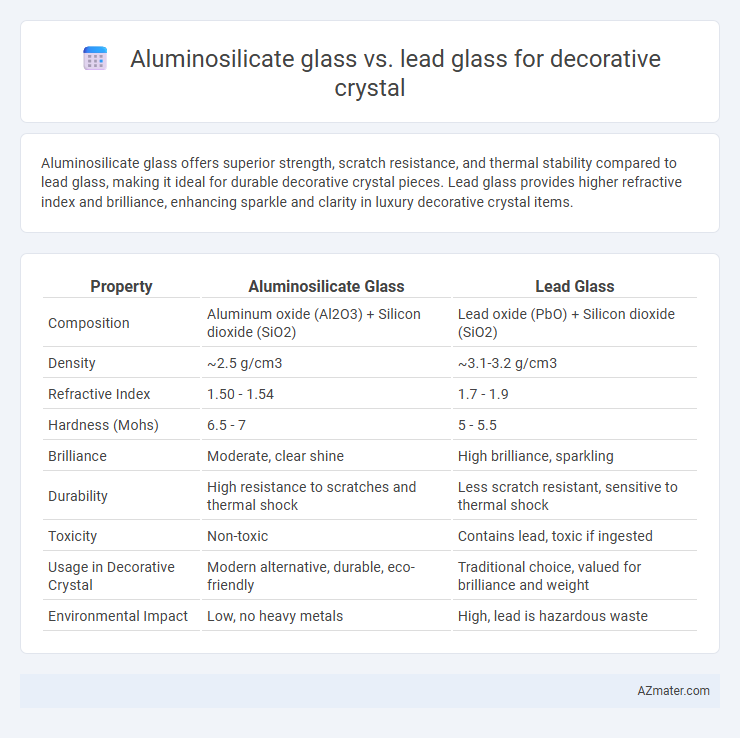Aluminosilicate glass offers superior strength, scratch resistance, and thermal stability compared to lead glass, making it ideal for durable decorative crystal pieces. Lead glass provides higher refractive index and brilliance, enhancing sparkle and clarity in luxury decorative crystal items.
Table of Comparison
| Property | Aluminosilicate Glass | Lead Glass |
|---|---|---|
| Composition | Aluminum oxide (Al2O3) + Silicon dioxide (SiO2) | Lead oxide (PbO) + Silicon dioxide (SiO2) |
| Density | ~2.5 g/cm3 | ~3.1-3.2 g/cm3 |
| Refractive Index | 1.50 - 1.54 | 1.7 - 1.9 |
| Hardness (Mohs) | 6.5 - 7 | 5 - 5.5 |
| Brilliance | Moderate, clear shine | High brilliance, sparkling |
| Durability | High resistance to scratches and thermal shock | Less scratch resistant, sensitive to thermal shock |
| Toxicity | Non-toxic | Contains lead, toxic if ingested |
| Usage in Decorative Crystal | Modern alternative, durable, eco-friendly | Traditional choice, valued for brilliance and weight |
| Environmental Impact | Low, no heavy metals | High, lead is hazardous waste |
Introduction to Decorative Crystal Glass Types
Decorative crystal typically utilizes aluminosilicate glass and lead glass, each offering distinct optical and physical properties for design applications. Aluminosilicate glass is valued for its high durability, scratch resistance, and clarity, making it ideal for intricate and long-lasting decorative pieces. Lead glass, enriched with lead oxide, provides superior brilliance, weight, and refraction, enhancing the sparkle and visual depth of luxury crystal items.
Overview of Aluminosilicate Glass
Aluminosilicate glass is a durable material known for its high resistance to thermal shock and mechanical strength, making it an excellent choice for decorative crystal applications requiring longevity and robustness. Unlike lead glass, aluminosilicate glass is environmentally friendly due to the absence of toxic lead content, offering a safer alternative without compromising clarity or brilliance. Its enhanced chemical stability and scratch resistance provide superior performance in luxury decorative items, where both aesthetic appeal and durability are paramount.
Overview of Lead Glass
Lead glass, also known as lead crystal, contains typically 24-30% lead oxide, which enhances its refractive index and brilliance, making it highly prized for decorative crystals and fine glassware. The high density of lead glass provides exceptional weight and clarity, enabling intricate cutting and engraving that reflects light beautifully. Compared to aluminosilicate glass, lead glass offers superior optical properties and a distinctive sparkle, although it is softer and more prone to scratching.
Composition and Material Differences
Aluminosilicate glass incorporates aluminum oxide (Al2O3) along with silica, providing enhanced strength, thermal resistance, and durability compared to lead glass, which primarily uses lead oxide (PbO) to achieve higher density, brilliance, and a characteristic sparkle. The chemical composition of aluminosilicate glass results in a more chemically stable and scratch-resistant material, while lead glass offers superior refractive index and clarity, making it ideal for decorative crystal applications focused on optical brilliance. Material differences also influence weight and eco-friendliness, with aluminosilicate glass being lighter and less toxic than lead glass, contributing to safer manufacturing and sustainability in decorative items.
Optical Properties: Brilliance and Clarity
Aluminosilicate glass exhibits high durability and moderate brilliance, featuring a refractive index around 1.5, which provides clear optical performance but less sparkle compared to lead glass. Lead glass, enriched with lead oxide (typically 24-30%), offers superior brilliance and clarity due to its higher refractive index (approximately 1.7-1.9) and greater dispersion, resulting in enhanced light refraction and sparkling effects ideal for decorative crystal. The optical superiority of lead glass makes it the preferred choice for luxury decorative items where maximum sparkle and clarity are essential.
Durability and Strength Comparison
Aluminosilicate glass offers superior durability and resistance to scratches and thermal shock compared to lead glass, making it ideal for decorative crystal items exposed to frequent handling. Lead glass, known for its high refractive index and brilliant clarity, is softer and more prone to scratches and chipping, reducing its long-term strength. The enhanced mechanical properties of aluminosilicate glass contribute to longer-lasting decorative crystals, especially in high-use environments.
Health and Environmental Considerations
Aluminosilicate glass offers a safer alternative to lead glass by eliminating toxic lead content, reducing health risks associated with lead exposure such as neurological damage. Environmentally, aluminosilicate glass is more eco-friendly due to its reduced toxicity and better recyclability, minimizing hazardous waste and soil contamination. Lead glass, while prized for its brilliance and weight, poses significant environmental challenges in disposal and manufacturing emissions, making aluminosilicate a preferable choice for sustainable decorative crystal production.
Design Versatility and Artistic Applications
Aluminosilicate glass offers exceptional design versatility due to its high durability and scratch resistance, making it ideal for intricate and modern decorative crystal designs. Lead glass, with its higher refractive index and brilliant clarity, excels in artistic applications requiring enhanced light dispersion and rich brilliance, commonly favored in traditional crystal art. Both materials allow for detailed craftsmanship, but aluminosilicate glass supports innovative shapes and contemporary aesthetics, while lead glass remains preferred for classic, luxurious decorative crystal pieces.
Cost and Market Availability
Aluminosilicate glass offers a cost-effective alternative to lead glass, with lower raw material expenses and safer manufacturing processes, making it attractive for budget-conscious decorative crystal producers. Market availability of aluminosilicate glass has expanded due to growing environmental regulations limiting lead content in consumer products, boosting its presence in decorative crystal applications. Lead glass remains popular for its superior brilliance and weight, but higher cost and increased regulatory restrictions limit its market share compared to more sustainable aluminosilicate options.
Choosing the Right Glass for Decorative Crystal
Aluminosilicate glass offers superior strength, scratch resistance, and thermal stability compared to lead glass, making it ideal for decorative crystal items exposed to daily use or heat. Lead glass, known for its high refractive index and brilliance, provides exceptional clarity and sparkle that enhance the aesthetic appeal of luxury decorative pieces. Selecting between aluminosilicate and lead glass depends on the balance between durability requirements and the desired optical brilliance in the final crystal design.

Infographic: Aluminosilicate glass vs Lead glass for Decorative crystal
 azmater.com
azmater.com